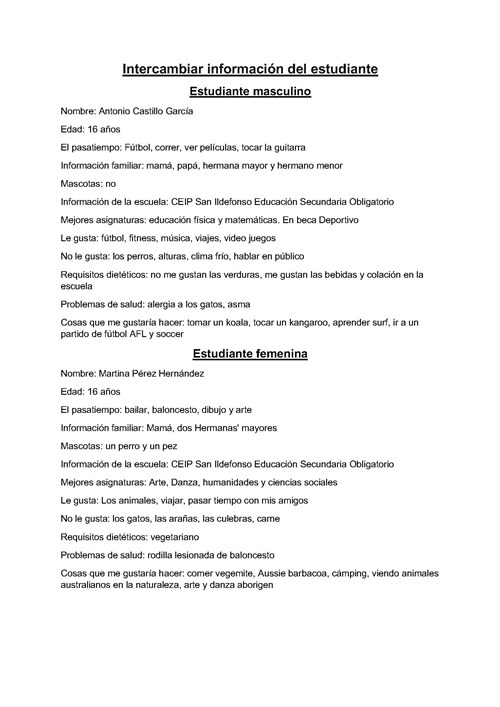Languages: Spanish - Satisfactory - Years 9 and 10 (Year 7 entry)
Portfolio summary
This portfolio of student work shows that the student can interact in written and spoken Spanish to communicate about personal experiences (WS1, WS2, WS3), relationships and aspirations, and broader local and global issues such as the environment (WS5), social media and tourism (WS4), including issues that pertain to Spanish-speaking countries. The student interacts with peers to make decisions, solve problems, and negotiate and plan action in response to issues (WS1, WS2). When interacting, the student uses both rehearsed and spontaneous language and appropriate protocols to express and compare opinions, share perspectives, and express agreement or disagreement (WS3). The student applies rules of pronunciation, stress and intonation to a range of sentence types (WS3, WS5). The student locates, summarises and analyses information from a range of texts (WS4), and communicates different perspectives and information in a range of contexts using different modes of presentation (WS1, WS3, WS4, WS5). The student responds to and creates personal, descriptive, informative and imaginative texts for different purposes, audiences and contexts (WS3, WS5) using appropriate Spanish writing conventions (WS1, WS2, WS4). The student uses grammatical elements including present, imperfect, past and future tenses, reflexive verbs, and the subjunctive mood to express emotion (WS1, WS2, WS3, WS4, WS5). The student uses appropriate forms of possessive adjectives in own language production, as well as cohesive devices and prepositions to create cohesion and interest (WS1, WS2, WS3, WS4, WS5). The student uses relative pronouns, relative clauses and adverbial phrases to extend and elaborate their written texts (WS1, WS2, WS4, WS5). The student works in Spanish and English to translate and create bilingual texts, explaining words or expressions that are culturally specific (WS4). The student describes their own reactions in intercultural exchanges and explains how their own assumptions and identity influence their language use (WS1, WS4).
The student identifies differences in accent and pronunciation across the Spanish-speaking world in different regions and countries (WS2, WS4). The student uses metalanguage to explain features of language (formal and informal language) and grammar and for reflecting on the experience of Spanish language and culture learning (WS1, WS2, WS4). The student identifies relationships between parts of words (prefixes and suffixes) and stems of words, and how word patterns connect words in semantic families. The student analyses the textual features of a range of texts in different modes and identifies how these shape responses and influence meaning (WS2, WS4). The student gives examples of how Spanish is used in a variety of ways to achieve different purposes in different contexts and for different audiences (WS1, WS2, WS4). The student describes changes in the role of Spanish as a global language and explains how language both influences and reflects culture (WS1, WS2, WS4). The student knows that Spanish is co-official with many other languages in a range of countries, such as Guaraní in Paraguay; Quechua in Bolivia, Ecuador and Peru; and Basque/Euskera, Catalan and Galician in Spain (WS4). The student explains how meanings and interpretations vary according to the cultural assumptions that people bring to interactions, and considers how learning a second language provides the opportunity to view oneself from the perspectives of others (WS1, WS2, WS4).





